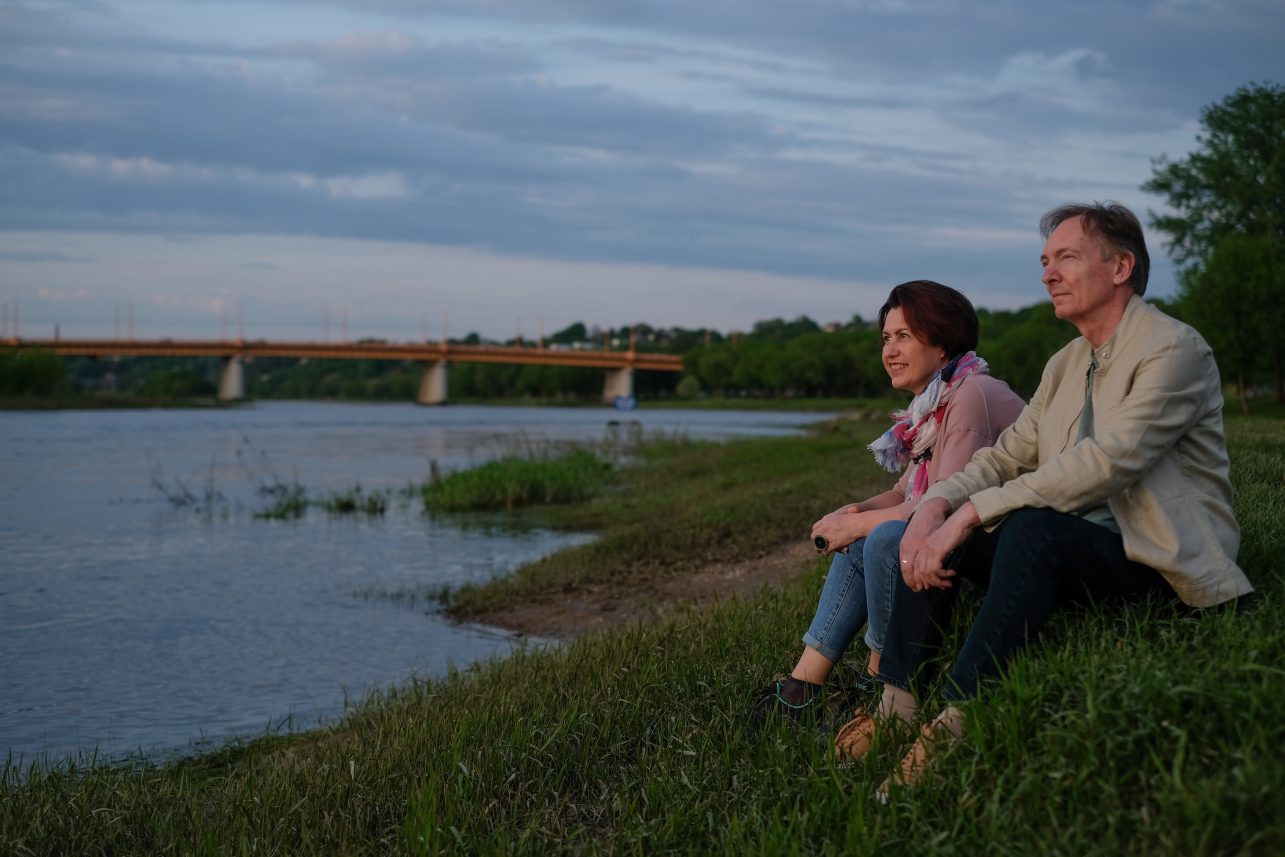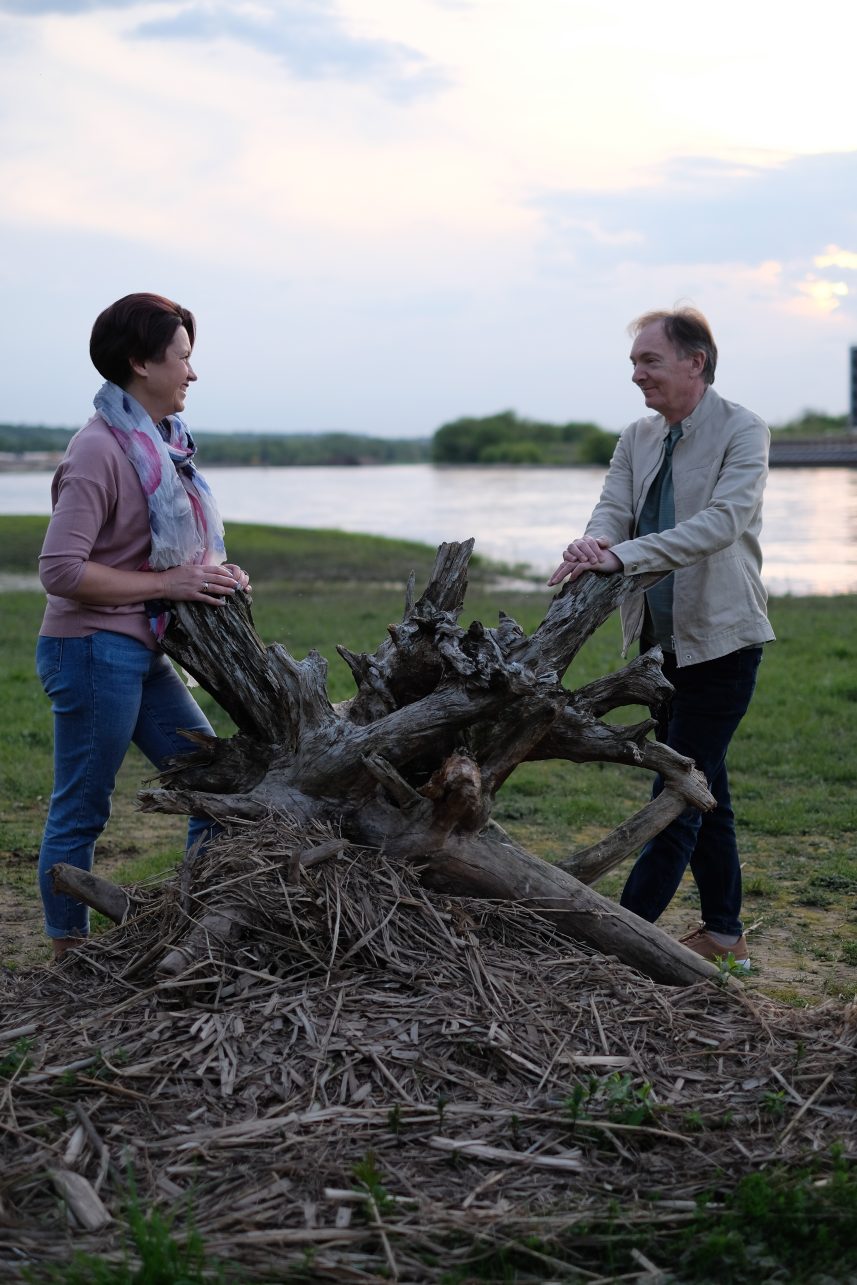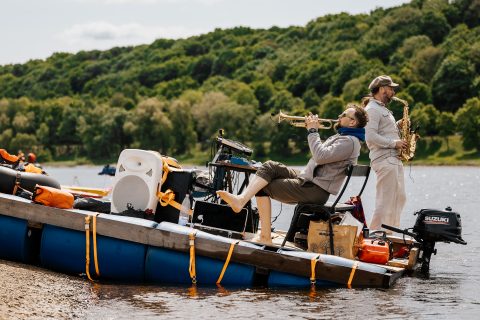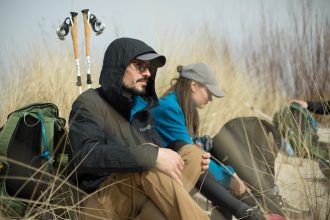When we talk about watercolour, we often think of pastel sunset landscapes, flower arrangements, or colourful portraits of people and animals. Watercolour fascinates many with its limpidity, softness, and lightness. Perhaps this has determined the popularity of amateur watercolour painting as a hobby or even a trendy way of tattooing for a time. This art technique has traditionally been a part of aristocratic education: the current monarch, King Charles III, engaged in watercolour painting as well. What does professional watercolour look like, how does it change, and what is special about working with it? We covered these questions with the organizers of the International Watercolour Biennial Baltic Bridges: artist and author of the initiative Eugenijus Nalevaika and art critic Jovita Nalevaikienė. This year, the stereotype-breaking biennial will take place from July 11.

What got you interested in watercolour?
Eugenijus: At Kaunas Art School (now Kaunas Art Gymnasium), I studied under watercolour master Česlovas Kontrimas. Unfortunately, there was little time for it and the understanding of what watercolour is comes only after many years of work. Later at the Vilnius Academy of Arts, I got to work with watercolour again. The first attempts were quite unsuccessful, but the desire and stubbornness to make friends with it propelled me forward. I remember, after the third year in the academy, during the summer practice in Juodkrantė, we were making watercolour paintings one after another, and eventually, I started succeeding. Since then, I have not parted with this technique. The first steps toward exhibitions were made in 1984, so you can say that this year is an anniversary year for me as a watercolourist.
What makes this painting technique unique? Does working with watercolour require specific human qualities?
Eugenijus: Watercolour requires a lot of patience and concentration and at the same time a quick reaction. No matter how many years you work with pigments and water, you cannot predict the final result. In the process, you might have to change your idea, adapt, and capture the moment. What makes watercolour complicated is that the shades and intensity of the paint change radically when it is drying. You need to be able to predict those changes.
Jovita: We wrote in one catalogue that watercolour is like a capricious lady: you can’t tell her what to do because this is how the water is drying today. Watercolour is primarily distinguished from other painting techniques by its clarity, visible layers of pigments, and clearness. It is possible to paint with watercolours quite richly and intensively, to obtain textures and color gamut similar to other techniques but what makes watercolour unique is that it seems to shine. Masterfully created watercolours use the whiteness of the paper, and when the painting is illuminated, it appears that the light is coming from the other side. True watercolour does not contain white pigment paint – the white colour is created by leaving areas unpainted.
Watercolour has long been used for sketching – as a travel tool for painters and cartographers. When travel books appeared in the 17th and 18th centuries, watercolour was used to create illustrations for expeditions, diaries, and maps. Watercolour is convenient; it only needs pigment, water, and a piece of paper. Art historians indicate such a watercolour technique as alla prima; when a drawing is created in one go in two or three layers, the paint is quickly applied wet-into-wet and dries equally quickly. That’s how small-format travel paintings were created.
Interestingly, some of the most famous examples of abstract painting – the paintings of Wassily Kandinsky – are watercolours. When it is necessary to defend the importance of watercolour, one wants to draw arguments that such masters like Kandinsky and Čiurlionis worked with this technique. Another interesting example of a watercolour painting is the late 15th and early 16th century miniature depicting the Grand Duke of Lithuania Vytautas the Great and his wife Ona, which was acquired by the Palace of the Grand Dukes of Lithuania in 2014. Sometimes critics say that watercolour is short-lived, that paper and paint will not last, but such examples show otherwise.
Eugenijus: It can be mentioned that the ancient Egyptian papyri are also watercolours, and they are not hundreds but thousands of years old. Yet the colours survived, although watercolour paints are usually created from completely natural materials: crushed mineral or vegetable pigments, honey, and gum Arabic.
What does the creative process look like when working with watercolour?
Eugenijus: The most important thing is the right attitude. Watercolour can be compared to jazz. You can’t play from sheet music here. The result changes during the process, and you have to improvise from some single color, from one brush stroke and the drip of water.
Jovita: Watercolour can be applied wet on wet paper, wet on the dry paper, and more experimentally, dry on a dry surface. In each case, the pigments bind differently or not at all. It is neither drawing nor traditional painting, although it is theoretically classified as such. Clean water is especially important for working with watercolour. If you want to achieve clear, clean, light colors, you must change the water with each new pigment. The rapid drying of watercolour is convenient for a small travel painting, but it presents challenges when working with large formats. For example, Eugenijus has created works with a width of one and a half meters and a length of six meters. Imagine the amount of planning, strategy, movement, and speed required to make a piece look even. In addition, it is almost impossible to correct mistakes in watercolour. When the painting dries, you can see all the layers, contours, and details that you tried to cover and paint over.
Eugenijus: We jokingly envy those who paint with oil or acrylic paint because they can take a break, rest, and have coffee. In watercolour, one layer must be completed in one go. The weather, room, or studio temperature has a great influence on the work. Even the temperature of the water influences how different paints come together and merge. I have colleagues who experiment with water of different temperatures – from coldest to warmest – and then analyze the results. The nuances are countless. You can experiment all your life, continue learning and some secrets will still remain uncovered.

What was your main goal when you started organizing the biennial? Does it remain the same today?
Eugenijus: Long before the biennial, when I was the chairman of the Kaunas watercolourists’ section, I was always saddened that the artists who create with this technique and their works seem to remain in the margins. At that time, traditional exhibitions of Kaunas artists were organized twice a year in the Picture Gallery. The most space on the best walls was given to oil paintings and sculptures, and a small dark corner was reserved for watercolours.
So, the idea was slowly shaping. We had an example in the neighboring Riga, the watercolour triennial started in the 1960s. Around 2000, Latvians started knocking on our door and offering to take over that tradition, because they already felt tired, and had difficulties getting funding and exhibition spaces. So, we started with this encouragement.
In 2006, we invited artists from countries around the Baltic Sea to the first international exhibition. It was a success, and the scale of the biennial started to grow, its geographical boundaries expanded. The reviews of foreign artists are encouraging. They say that this biennial is unique in Europe; it offers a contemporary look at the watercolour instead of sticking to traditional forms.
Unfortunately, little by little, we are also approaching a similar point as our colleagues from Riga, who passed on the tradition to us: we have been experiencing a lack of funding. I guess this means that the approach to watercolour has not changed enough in almost 20 years. There’s room for improvement. One of our achievements is that we managed to persuade many young painters and artists from other fields to try this technique. The fact that watercolour has not disappeared in Lithuania is already a success.
How do you select the artists for the biennial? What do you look for in their work? How do you decide how many different authors to feature?
Eugenijus: We have always tried to showcase the widest range of watercolour techniques and topics. We also do not refuse realistic works, if they are somehow unique. We would not like the biennial to become completely uniform; the individual traditions of each country allow us to maintain diversity. Today, of course, the differences between the countries are disappearing. In the past, it was very easy to distinguish between Lithuanian and Latvian or Estonian watercolours. Scandinavian style remains very distinct even today. Perhaps that is dictated by natural conditions. Scandinavians use few colours. The works are dominated by black and white with additional grey and brown shades. There are countries whose artists usually use bright colours. Those differences are fascinating. And the most important criterion is, of course, mastery.
Jovita: If we had sufficient funding, when choosing the works, we would like to see them live, not on a computer screen. However, the mistakes are rare. When choosing works from photos, we can sometimes miss scratches and other damages caused by the quality of the paper, which will make the work look a little worse in real life. However, the opposite also happens when an artwork we selected rather doubtfully arrives and pleasantly surprises us appearing as if in a new light.
Biennial exhibitions feature traditional and mixed-media works or even those created in other mediums, but are watercolour-like and reflect the basic principles of watercolour. We aim to broaden the watercolour concept and show why it is interesting and valuable.
Some artists submit their works for selection every year, others send them once and do not try again. There are those who, despite not being selected by the jury for three years in a row, still try, and we can even see their progress.
Eugenijus: The number of participants is limited by space. We don’t want to hang the works three stories above each other, because that devalues the art and the author. It is better to have less but exhibit more respectfully.
Jovita: I want to reveal the style of the artist. This requires at least two, three, and preferably, four or five pieces. If they are large format, it requires a lot of space. If they are small, you can fit more, but if you overdo it, you will end up walking around the hall cradling your head in your hands. However, at least fifteen countries participate in each biennial, and throughout all the years, about a thousand artists have submitted their works for selection.

What will be special about this year’s jubilee biennial? Could the challenges you mentioned mean that it will be the last?
Jovita: This year’s theme is X. X is the point from which we start counting when talking about coordinates, and it also means ten. The theme has various meanings and depths. It invites us to think about how far we can go in those ten years and the history of the biennial. At the same time, the topic is somewhat mystical because X is also an unknown quantity, a question, “What’s next?”
We are planning master classes. We really want to invite foreign masters to share their experiences. We have many ideas that, unfortunately, are limited by the budget. There will definitely be curator-guided tours. After all, it is very important to talk about creative work because the authors’ and art critics’ comments allow visitors to see artworks from a different perspective. We also hope to publish a catalog of the exhibition.
Eugenijus: This year we will have quite a few spaces for exhibitions. They will take place in the Kaunas Picture Gallery, Drobė Gallery, and the ZOO Gallery of the T. Ivanauskas Zoological Museum. We also plan to present the works later in Panevėžys. We hope the biennial will continue, but we would like others to take over the organization, at least for the most part. Perhaps the youth could show us a new point of view.




